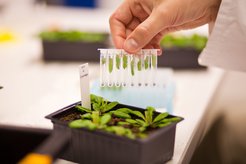Playing hide and seek in the centromere
Tug-of-war between selfish gene and cellular clean-up mechanism generates genetic diversity
Centromeres, the DNA sections often found at the center of the chromosomes, display enormous interspecies diversity, despite having the same vital role during cell division across almost the entire tree of life. An international team of researchers has discovered that the variation in centromere DNA regions can be strikingly large even within a single species. The findings shed light on the molecular mechanisms of rapid centromere evolution and their potential role in the formation of new species.

There is a special region in each chromosome, often found at its center: its centromere. During cell division, it ensures that new cells – from sperm and eggs to skin and neurons – end up with the correct number of each chromosome. Despite their role in cell division staying the same across almost all plants and animals, centromeres of different species surprisingly vary radically in size and structure. Biologists have termed this contrast between extreme diversity and ultra-conserved function the ‘centromere paradox’.
This apparent contradiction inspired an international research team led by Ian Henderson (University of Cambridge), Detlef Weigel (Max Planck Institute for Biology Tübingen), and Alexandros Bousios (University of Sussex) to investigate plant centromere diversity and its origins. The researchers considered two alternative hypotheses: The large diversity could be shared by all species and passed down from a common ancestor. Alternatively, it could be recent, emerging only after the species began to diverge from one another.
To find out, the team analyzed a large number of individuals from Arabidopsis thaliana, a common roadside weed and a favorite model organism of plant scientists, as well as material from the sister species Arabidopsis lyrata. The team was surprised that centromeres from very closely related individuals could have substantial structural differences. “In a way, our analysis proved both our alternative hypotheses true”, Weigel summarizes: “There is striking diversity within the species; but comparing the two species with each other, the differences look even more extreme.”
Invasion by a selfish gene
The large centromere variety raises the question how the rapid diversification came about. The team found that Arabidopsis centromeres have recently been invaded by a mobile genetic element called ATHILA. This “selfish gene” is a distant relative of retroviruses such as HIV, yet lacks the ability to escape the cell. The invasion is countered by the clean-up machinery that continuously polices the genome for foreign elements: to ensure continued centromere function, the cell frequently overwrites parts of it, thereby often eliminating the new ATHILA elements. This is how small building blocks of DNA may be eliminated or copied over and over again, causing the centromeres to grow or shrink and diversify from one another.
“It seems as if these repeated cycles of invasion and purging are the main drivers of rapid centromere evolution”, concludes Fernando Rabanal from Weigel’s lab. These mechanisms might be paralleled in other species, including humans: “It is amazing to think that the hide and seek between centromeres and their mobile invaders may be repeated across species”, Bousios emphasizes. “The game remains the same, yet the actors change.”
Illuminating the dark matter of a genome
In future work, the researchers want to deepen their understanding of the mechanisms of these rapid changes and investigate in-depth how centromere variation contributes to species formation: “We have examined centromere diversity deeply within one species”, Henderson notes. “In the future, it will be important to study centromere diversity and evolution across the entire tree of life.” Henderson’s team member Robin Burns wonders: "The rapid changes in the centromere raise the question what threshold of differences between two plant centromeres can be tolerated during cell division.” The open questions sparked by the results are manifold, as their colleague Piotr Wlodzimierz points out: “We have yet to fully understand mechanisms of creation and evolution of centromeric repeats. Recognizing their diversity is but the first step in a journey that illuminates the dark matter of a genome.”












